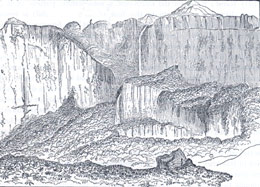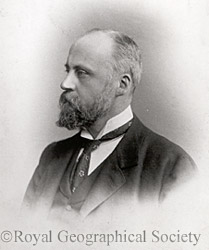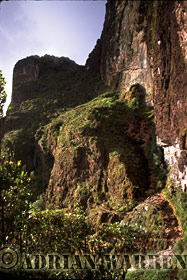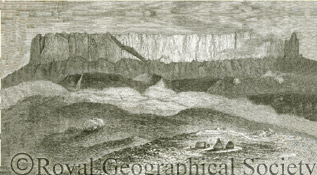 |
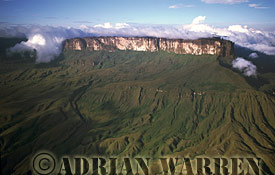 |
Roraima and the ledge, from the sketch by Henry Whitely, 1884 |
Roraima and the ledge, 2000 |
By now, the provisions they had brought with them from the coast would have started to dwindle, and they would have had to rely to a large extent on hunting for fresh meat. But it is a common misconception that, in the rain forest, animals dangle from every tree. The animals are there, a fact confirmed by the rich cacophony of sounds all around, but the sources remain concealed behind curtains of tangled vegetation. To survive in the forest an animal must remain hidden from potential predators, and the heavy sounds of humans moving through the undergrowth would have triggered alarm responses from ever watchful birds high in the canopy above; the sentinels of any approaching danger. For the explorers, struggling through the undergrowth below, the forest was a dark, steamy place, with no horizon, no view of more than a few feet, and only brief glimpses of sky. A place where, without a compass, it is easy to lose your bearings and walk around in circles. Day after punishing day, they pushed on through the gloomy, dank forest toward their goal, Mount Roraima. It seemed to them to go on forever, dulling their senses to annihilation.
|
|
The Ledge of Roraima, from a sketch by Im Thurn, 1885 |
The Ledge of RORAIMA, 2000 |
Quite suddenly, though, the forest ends in a distinct line, and their path passed out of the deep forest shadows on to wide open savannah. At last there was a horizon, but it took a few moments to adjust their eyes to the bright sunlight, to gaze at rolling grasslands, and mountains in the distance. The sun cast welcome and warming rays on their faces, and a breeze helped to dry their perspiration soaked clothes.
With renewed vigour, the explorers walked briskly along ridges of open savannah and, with every step, they came closer to the mountain. On this part of their journey, they made special note in their journals of the paucity of wildlife, apart from some Giant Ant-Bears and of Rattlesnakes. It is the custom of local people to burn the savannah, by way of celebration, but this habit effectively kills any wildlife by burning, or drives animals away. The explorers' last contact with any human settlement would have been at the village of Teruta, a thriving indigenous village where they could find food and shelter. It was situated on a low hilltop above the River Kukenaam, commanding an impressive panorama of the two tepuis, Roraima and Kukenaam. The mountains were only a few miles distant, but the view of the cliffs was often obscured by shifting cloud and mist.
The village of Teruta was abandoned in the 1920s but even now, as I found when I retraced the early explorers route, it is possible to see circular bare patches of earth where the huts once stood. It was from here that the explorers would have scrutinized the cliffs of Roraima hoping to find a possible ascent route, and perhaps dreaming of the Victorian fantasy of a prehistoric "Lost World", complete with dinosaurs and pterodactyls.
Most of the explorers who made it this far, had observed a sloping ledge that seemed to offer a possible path for an ascent, except that halfway up it had been eaten away by a waterfall and was therefore pronounced impassable. It must have been disheartening, for the only other option open to them was a long and difficult circumnavigation of the mountain in search of other possibilities. During their long approach to the mountain, many of them would have seen the eastern flank of Roraima, and noticed that the cliffs there seemed just as impregnable. One explorer wrote: "the summit of Roraima seems inaccessible, except perhaps by means of a balloon". Most of the expeditions, having travelled so far and by now short of food, gave up and made plans to return home. One very enterprising visitor to the area, who was not so obsessed with trying to reach the summit, was ornithologist Henry Whitely. A remarkable man, he spent several months, working alone, collecting birds in the vicinity of Roraima in 1883. One of his principal aims was to search for a species of bird known only from one specimen and said to come from the slopes of Roraima at around 6,000 feet, so he therefore determined to climb to the base of Roraima's perpendicular wall. At that time there was a considerable belt of forest on the flanks of the mountain, between the base of the cliff and the gently rolling savannah further down. Much of this forest was later destroyed by a fire in 1925 started by the local Pemon people, but for Whitely, it was a formidable barrier: "It was," he wrote, "the densest underwood I have ever passed through." The slope which became ever steeper, is formed from rocks breaking away from the sides of the mountain, covered in trees and tangled undergrowth. Whitely did, however, reach the cliff but not the base of the ledge, which he had hoped to examine in more detail. In his opinion, from what he could see from his highest observation point, the break half way up the ledge might perhaps be crossed by using ropes, but it did not look to be easy. He also felt that a successful expedition should be prepared to stay on the summit for a long time, in order to study its animal and plant life in sufficient detail to make all the effort worthwhile.
Encouraged by Whitely's report, published in the Proceedings of the Royal Geographical Society of London in 1884, Sir Joseph Hooker, an eminent botanist, used his influence to find the necessary funds to support another expedition to attempt to reach the summit, this time by way of the ledge. His friend, Everard Im Thurn, a Magistrate, agreed to undertake the trip, accompanied by Harry I. Perkins, an Assistant Crown Surveyor. Both, at the Departing from a point near the coast, it took Im Thurn and Perkins nearly eight weeks to reach the Indian village of Teruta, on the southern slope of Roraima. Their first impression of the ledge was that it looked so easy to climb that they concluded that there must be some insuperable difficulty of which they were unaware. Having climbed along Whitely's trail to the base of the cliff in order to view the ledge more closely, they employed Indians to cut a trail through the forest to the base of the ledge itself.time, were living in British Guiana, so were well placed to undertake such an expedition.
The forest was very dense, the stunted trees matted together in a tangle of roots and bamboo. Every surface was covered in spongy moss, and saturated with moisture. Clambering over slippery masses of wet and slimy vegetation, tangled enough to bear their weight; over high piled rocks and tree roots, with the sound of trickling water far below, at last they reached the base of the cliff where the ground was dry due to the considerable overhang of the rock.
As they approached the base of the ledge, they were able to see that the lower part of it was broken, consisting of large masses of rock which towered over the forest. The lower part of the ledge was difficult, but not dangerous, their trail taking them over, under, and along branches, tree roots, boulders, and up steep slopes of slippery mud, every object wrapped in spongy wet moss and a glutinous alga that clings to surfaces as a jelly. Finally they reached the break in the ledge at the waterfall, which everyone had pronounced impassable, but which turned out to be a broad, sloping reach of broken rocks. Luckily the waterfall was not in full spate, and they reached the upper section of the ledge quite easily. The explorers made fast progress up the remaining section of the ledge, until they reached a point where just a few steps more would bring their eyes on a level with the top, to discover the secrets of Roraima.
